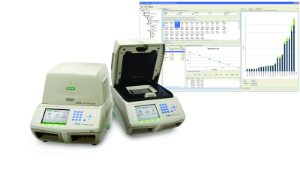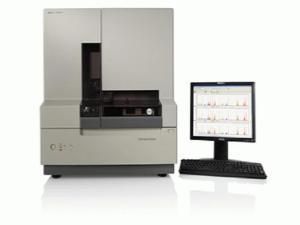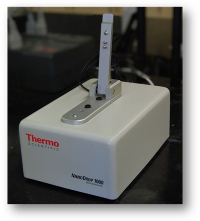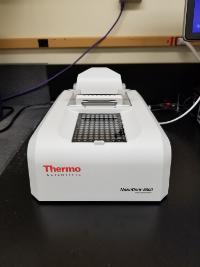Shared Resources
 With technologically advanced solid-state optics, these systems deliver detection sensitivity and quantitation precision with up to five-target multiplexing discrimination. The accompanying software (CFX Manager) provides intuitive navigation tools and helpful wizards for ease-of-use, with customizable data analysis and display features. These instruments require a reservation for use.
With technologically advanced solid-state optics, these systems deliver detection sensitivity and quantitation precision with up to five-target multiplexing discrimination. The accompanying software (CFX Manager) provides intuitive navigation tools and helpful wizards for ease-of-use, with customizable data analysis and display features. These instruments require a reservation for use.
 This system provides a single platform upon which the analysis of size, quantity, and quality of DNA, RNA, protein, or cells can be performed, with a high-quality digital readout of data. A kit specific to your sample type is necessary for system use.
This system provides a single platform upon which the analysis of size, quantity, and quality of DNA, RNA, protein, or cells can be performed, with a high-quality digital readout of data. A kit specific to your sample type is necessary for system use.
 This four-capillary, automated instrument is easy to use and provides data quality and instrument reliability. This instrument is part of our fee-for-service offering.
This four-capillary, automated instrument is easy to use and provides data quality and instrument reliability. This instrument is part of our fee-for-service offering.
 The iSeq 100 Sequencing System is a next generation sequencer for DNA and RNA. The iSeq 100 System is ideal for small whole-genome sequencing (e.g., bacteria, viruses, plasmids), targeted sequencing of a set of genes or gene regions, gene expression analysis or 16S metagenomics.
The iSeq 100 Sequencing System is a next generation sequencer for DNA and RNA. The iSeq 100 System is ideal for small whole-genome sequencing (e.g., bacteria, viruses, plasmids), targeted sequencing of a set of genes or gene regions, gene expression analysis or 16S metagenomics.
This compact and automated gel-imaging instrument can produce publication-quality images. Samples can be imaged using your choice of four application-specific trays:
- UV (e.g., ethidium bromide)

- White (e.g., coomassie or silver stains)
- Blue (e.g., SYBR)
- Stain-free (for use with Bio-Rad stain-free gels)
The system comes with ImageLab software for analysis with a free-downloadable software package available for convenient analysis at your desk.
 The Axygen Gel Documentation system easily captures publication-quality, 16-bit TIFF images that can be opened in common gel analysis software for more detailed analysis. The system has an exceptionally high resolution (5.4 MP) camera with dual wavelength transilluminators (UV 302, UV 365, Epi White). Imaging tools include crop, rotate, resize, contrast, saturation and zoom. Annotation tools include a variety of text and drawing tools.
The Axygen Gel Documentation system easily captures publication-quality, 16-bit TIFF images that can be opened in common gel analysis software for more detailed analysis. The system has an exceptionally high resolution (5.4 MP) camera with dual wavelength transilluminators (UV 302, UV 365, Epi White). Imaging tools include crop, rotate, resize, contrast, saturation and zoom. Annotation tools include a variety of text and drawing tools.
 This instrument can detect an accurate concentration of nucleic acid using only 1.5 – 2 uL of sample. In addition, 260/280 and 260/230nm ratios are provided as sample-quality information. This instrument can also be used to determine the concentration of proteins, with a standard curve function for known standard to provide protein concentration determination.
This instrument can detect an accurate concentration of nucleic acid using only 1.5 – 2 uL of sample. In addition, 260/280 and 260/230nm ratios are provided as sample-quality information. This instrument can also be used to determine the concentration of proteins, with a standard curve function for known standard to provide protein concentration determination.
 This instrument quantitates nucleic acid or protein in samples of 1.5-2 ul with the capability of measuring up to eight samples simultaneously. Sample quality data is the same as the Nanodrop 1000. When using an eight-channel pipette to dispense samples, 96 samples can be measured in less than six minutes.
This instrument quantitates nucleic acid or protein in samples of 1.5-2 ul with the capability of measuring up to eight samples simultaneously. Sample quality data is the same as the Nanodrop 1000. When using an eight-channel pipette to dispense samples, 96 samples can be measured in less than six minutes.
 The BioTek EL808 is available for absorption values (colorimetric readings) of samples in 96-well plates. Various wavelengths are available.
The BioTek EL808 is available for absorption values (colorimetric readings) of samples in 96-well plates. Various wavelengths are available.
The BioTek Synergy HTX can read microplates from 6- to 384-wells. It offers absorbance readings at customizable wavelengths, and a selection of excitation/emission wavelength filters for fluorescence and luminescence readings. Additional features include shaking and temperature control up to 50°C.
 The SpectraMax iD3 Microplate Reader can be used by itself or in conjugation with SoftMax Pro 7 Software. The SpectraMax iD3 reader measures absorbance. Features include temperature control up to 65 degrees Celsius as well as orbital and infinity shaking.
The SpectraMax iD3 Microplate Reader can be used by itself or in conjugation with SoftMax Pro 7 Software. The SpectraMax iD3 reader measures absorbance. Features include temperature control up to 65 degrees Celsius as well as orbital and infinity shaking.
 A centrifugal type piece of equipment with an attached vacuum to remove moisture to concentrate or dry samples. Samples can be "speed vac’d" with or without heat.
A centrifugal type piece of equipment with an attached vacuum to remove moisture to concentrate or dry samples. Samples can be "speed vac’d" with or without heat.
 The CLx uses direct infrared fluorescence detection to provide qualitative or quantitative analysis of western blots with a wide linear range. Two detection channels are utilized: 700nm (red) and 800nm (green), allowing for the detection of two separate targets in the same experiment. The CLx has increased sensitivity, over the Odyssey Classic, without signal saturation and allows for band normalization. Coomassie-stained gels can be imaged using the 700nm laser. The new D-DiGit DNA gel scanner uses high-sensitivity LED detection to provide a platform for gel visualization using fluorescent-safe stains, such as SYBR® safe.
The CLx uses direct infrared fluorescence detection to provide qualitative or quantitative analysis of western blots with a wide linear range. Two detection channels are utilized: 700nm (red) and 800nm (green), allowing for the detection of two separate targets in the same experiment. The CLx has increased sensitivity, over the Odyssey Classic, without signal saturation and allows for band normalization. Coomassie-stained gels can be imaged using the 700nm laser. The new D-DiGit DNA gel scanner uses high-sensitivity LED detection to provide a platform for gel visualization using fluorescent-safe stains, such as SYBR® safe.
The XF allows qualitative viewing of near-infrared (NIR) and enhanced chemiluminescent (ECL) Western blots, or DNA gels. It has channels at 600, 700, and 800nm as well as one specialized for streptavidin/HRP.
The Covaris M220 Focused-Ultrasonicator runs a variety of DNA shearing protocols with Covaris SonoLab 7 software and uses both the Covaris microTUBE and miniTUBE (disposables). The integrated temperature control eliminates the need for an external chiller. Covaris AFA® (Adaptive Focused Acoustics®) controls the shearing forces that fragment nucleic acids to the selected size. The M220 is designed for NGS applications requiring fragment sizes of 150bp – 5kb.
The Amaxa Biosystems Nucleofector allows for electroporation-based transfection enabling the transfer of nucleic acids into cells by applying a specific voltage (sign-out for use).
The DSA Ultrasonic Cleaner provides quick and easy cleaning in a water-bath format (sign-out for use).



